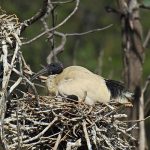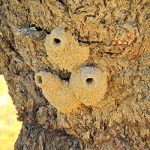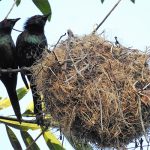COMMUNAL NESTS
Nature’s Neighbourhoods in the Trees
What is a Communal Nest?
A communal nest is a remarkable structure shared by multiple birds, sometimes for breeding, protection, or even just daily living. Unlike solitary nests, where one pair of birds raises their young in isolation, communal nests bring together groups of birds in a single, often expansive and intricate nest site. These shared homes can be found in tree branches, cliff faces, reeds, and even man-made structures, bustling with a vibrant array of activity.
Why Do Birds Nest Together?
Birds choose to nest communally for many reasons:
- Safety in Numbers: Nesting in groups helps birds defend against predators. There are more eyes to spot danger and more beaks to ward it off.
- Thermal Benefits: Large nests can help retain warmth, especially useful in colder climates or seasons.
- Resource Sharing: Birds can share the effort of building and maintaining a large nest, saving time and energy.
- Social Interaction: Communal nests support social bonds and group learning, as younger or less experienced birds observe and imitate experienced nesters.
Living in a Communal Nest
Imagine the sights and sounds within a communal bird’s nest:
- Visually: Multiple entrances, twigs interwoven with leaves, and flashes of colour as dozens of birds come and go.
- Auditory: A constant hum of chirping, calling, and the flutter of wings; a living chorus greeting each sunrise.
- Tactile: The nest itself might feel warm and gently vibrating with the activity of many tiny inhabitants.
The Importance of Communal Nesting
Communal nests are not only marvels of animal architecture but also crucial for the survival of many bird species. They teach us about:
- Cooperation: Birds demonstrate teamwork and mutual support.
- Adaptation: Communal living helps birds navigate environmental challenges, such as food scarcity or extreme weather.
- Biodiversity: These nests can become miniature ecosystems, supporting other creatures like insects and small reptiles.
Conservation and Respect
As we encounter communal nests in the wild, it is vital to respect their space. Disturbing these nests, even unintentionally, can disrupt breeding cycles and reduce the chances of survival for young birds. Simple actions, such as observing from a distance and keeping habitats intact, help preserve these neighbourhoods in the trees.
Communal nests are more than just bird homes; they are living examples of community, resilience, and the wonders of Australian wildlife. By learning about and protecting these natural marvels, we help ensure that the chorus of communal nesters continues for generations to come.










